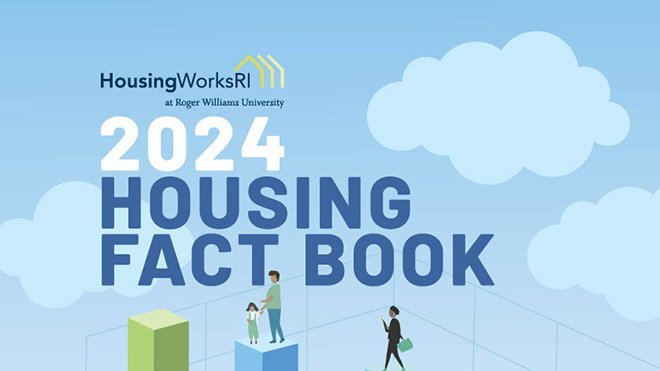HousingWorks RI at RWU Releases 2024 Housing Fact Book
In the 2024 Housing Fact Book, HousingWorks RI reviews 20-year trends and continues to highlight affordability challenges facing Rhode Islanders.

PROVIDENCE, R.I. – HousingWorks RI (HWRI) at Roger Williams University released the 2024 Housing Fact Book today, presenting a comprehensive analysis that seeks to shed light on the Ocean State’s housing affordability crisis. The report highlights the significant challenges faced by Rhode Islanders in securing or sustaining a safe and affordable place to live amid rising housing costs across the state.
The 2024 Housing Fact Book, HWRI’s annual publication of housing trends across the state, its regions, and municipalities, highlights a profound gap between incomes and housing costs, with no municipality in Rhode Island where a median homeowner income of $107,452 can affordably buy a home. Since 2018, median single-family home prices have surged throughout the state, increasing from 18 percent in Glocester to 112 percent in Central Falls. In 10 municipalities, home prices have risen by 50 percent or more.
The affordability crisis extends beyond homeownership, affecting renters as well. The average rent for a two-bedroom apartment in Rhode Island is now $2,107, according to RIHousing’s 2023 Rental Survey, requiring an income of over $84,000 to afford. This exceeds the state’s median renter income by nearly $40,000.
The state’s housing wage, which is the hourly wage needed to afford a modest rental home at the U.S. Department of Housing and Urban Development’s fair market rent without spending more than 30 percent of income on housing, continues to outpace what many Rhode Islanders earn. The 2024 housing wage is $33.20 per hour, yet 92 percent of the top 20 fastest-growing occupations in the state do not meet this wage. Only two of these occupations pay enough to afford the average two-bedroom apartment, which requires an hourly wage of $40.52, while none offer wages high enough to afford the median single-family home, which would require $69.08 per hour.
“While affordability challenges continue to maintain momentum, Rhode Island has taken some key steps in the General Assembly this past year to work to combat this crisis,” said Brenda Clement, HWRI’s Executive Director. “The 2024 Housing Fact Book highlights state and federal investments, including a pilot low-income tax credit program of up to $30 million annually for five years, and the approval of a ballot initiative for a $120 million bond up for vote this fall to increase the availability of long-term affordable homes and support community revitalization. While these are important steps in the right direction, funding from the federal State Fiscal Recovery Funds program continues to represent the most substantial source of funding for housing in the state. We must continue to increase efforts and do more at every level to ensure Rhode Islanders have a safe, secure, and affordable place to call home.”
HWRI released the 2024 Housing Fact Book this morning during a breakfast event at the Providence Marriott Downtown. Community partners, industry leaders, and elected officials gathered to listen to a presentation of this year’s key findings by Annette Bourne, HWRI’s Research and Policy Director, and Toby Arment, HWRI’s Research Analyst. In addition to a report out, Juana Matias, HUD’s Regional Administrator, provided remarks. Santander and JPMorgan and Chase were leading level sponsors.
Regional Trends Signal Growing Housing Challenges
The 2024 Housing Fact Book delves into 20-year trends across Rhode Island’s regions, revealing several notable shifts:
- Household growth has outpaced population growth in all seven Census regions, with rates doubling or more in North RI, Southeast RI, South RI, and Central RI.
- Proportional shifts in the number of housing units by building type indicate a continued dominance of detached single-family housing units in five (North RI, East Providence County RI, Providence RI, Southeast RI, and South RI) of the seven regions.
- All regions experienced decreases in the proportion of renters paying less than 30 percent of their income on rent; and increases in renters paying 30-49 percent (i.e., cost burdened).
- All seven Census regions experienced proportional increases in single-person households. Six of seven regions experienced increases in two-person households (Southeast Providence County RI experienced a decrease).
- Proportional shifts in population across ages show that all seven regions decreased in their proportion of residents aged 0-17, and 35-49, and increased in their proportion of residents aged 50-64, and 65-79. Three regions saw increases in the proportion of residents aged 80 and older.
Key Findings at a Glance
The Fact Book provides further insights into the affordability crisis:
- More than a third of Rhode Island households (143,023) pay more than 30 percent of their income toward housing costs, making them housing cost burdened and leaving less money for households to spend on personal needs and in support of our local economies.
- Rhode Island’s homeownership rates for Black, Hispanic, and Asian households are 9, 14, and 8 percentage points lower than the U.S. rates.
- The state’s median single family home price for 2023 was $425,000, which would require an estimated monthly housing payment of $3,592, and an annual income of $143,687.
- Since the 2000 Decennial Census, the population of Rhode Island adults aged 50 and older has grown by nearly 123,000 people, and now comprises 39 percent of the state’s population compared to 29 percent in 2000.
The 2024 Housing Fact Book can be viewed at www.housingworksri.org.
